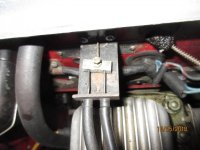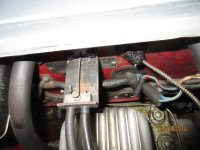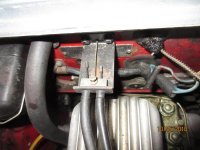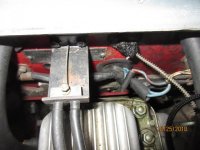-
 Hi Guest!
Hi Guest!
You can help ensure that British Car Forum (BCF) continues to provide a great place to engage in the British car hobby! If you find BCF a beneficial community, please consider supporting our efforts with a subscription.
There are some perks with a member upgrade!**Upgrade Now**
(PS: Subscribers don't see this gawd-aweful banner

Tips
- We have a special forum called "Member Articles" where you can submit actual articles for consideration for publication. Learn More
- Don't have an Avatar? If not, your avatar will default to the 1st character in your username. Go into "Account Details" to change your Avatar.
- Some basic forum navigation info: click
Hey - did you know if you click on the title of a thread it will take you to the first unread post since you last visited that thread?
- Hey Guest - Is your British Car Club in our Clubs database? If not, send me a PM - Basil

- Looking for a local club? Click the "Clubs" tab above and browse hundreds of clubs world-wide.
- Add Android or iPhone APP: click
- Did you know - any picture or video you add in your posts in any marque-specific forum will also get added to the Media Gallery automatically.
- A few more tips about posting and replying: click
- Hey there Guest - be sure to keep your profile page up to date with interesting info about yourself: learn more
- More tips and tricks on Posting and Replying: click
 STOP!! Never post your email address in open forums. Bots can "harvest" your email! If you must share your email use a Private Message or use the
STOP!! Never post your email address in open forums. Bots can "harvest" your email! If you must share your email use a Private Message or use the  smilie in place of the real @
smilie in place of the real @
- Want to mention another member in a post & get their attention? WATCH THIS

- So, you created a "Group" here at BCF and would like to invite other members to join? Watch this!
- Hey Guest - A post a day keeps Basil from visiting you in the small hours and putting a bat up your nightdress!
- Hey Guest - do you know of an upcoming British car event?
 Pretty Please - add it to our Events forum(s) and add to the calendar! >> Here's How <<
Pretty Please - add it to our Events forum(s) and add to the calendar! >> Here's How << 
- Hey Guest - you be stylin'
Change the look and feel of the forum to fit your taste. Check it out
- If you run across an inappropriate post, for example a post that breaks our rules or looks like it might be spam, you can report the post to the moderators: Learn More
- If you would like to try some different "looks" or styles for the site, scroll to the very bottom, on the left and click the Style Selector.
You are using an out of date browser. It may not display this or other websites correctly.
You should upgrade or use an alternative browser.
You should upgrade or use an alternative browser.
Choke sticking
- Thread starter fmcdonald
- Start date
Online
Detaching the cable from the choke arms will enable you to determine if the "stiffness/stickiness" is in one or both of the carburettors or the choke cable--or both. I have never had to lubricate a cable but should that be the cause it is not too difficult to work a lube into the cable jacket--perhaps dry graphite powder would work.
Bob_Spidell
Yoda
Offline
Common problem with BJ8s. The choke return springs on the carbs are too weak (I guess too strong and you'd have to be The Rock to pull the choke knob). I've tried everything: cleaning and lubing all shafts in the carbs, lubing the cables, etc. The only thing that really works is to rig some extra return springs attached to the enrichment arms on the carbs. I finally gave up; since you usually only need enrichment--SUs don't have 'chokes'--on the first/cold start after I check the oil I leave the bonnet open and start the car, when it's warm enough to run I push the arms down manually.
Offline
I installed 8-32 set screws at each end of the choke cables, this in combination with teflon-lined cable housings. This provides a positive return when you push the knob in. See:
https://www.pbase.com/stevegerow/healeychokes
This absolutely works.
https://www.pbase.com/stevegerow/healeychokes
This absolutely works.
Last edited:
Offline
I have not tried it yet, but Norman Nock has some springs which are added between the cable and the lever arms, (I am just going to use a hardware spring of appropriate size). Check out their website for parts and you will see how it works.
This originally called for "ballpoint pen" springs.
Offline
I had added extra springs connecting the choke enrichment levers from the carbs to the wheel well. It eventually wore out the bushings on the carbs plus it was harder to pull out the choke. This was after I removed the choke enrichment levers from the carbs and cleaned and lubricated it. The original springs work great as long as you keep everything clean and lubricated. Another issue was the choke cables being worn out. I cleaned and lubricated them with graphite and they worked so so. I replaced the choke cables with bike cables and my carb choke works great! Best thing I’ve done for my BJ8 chokes since buying my Healey since 1972. I also purchased springs from BCS to assist in the chokes going full off when choke is released. Several years ago many of us used a couple of ball point pen springs to do the same thing.Common problem with BJ8s. The choke return springs on the carbs are too weak (I guess too strong and you'd have to be The Rock to pull the choke knob). I've tried everything: cleaning and lubing all shafts in the carbs, lubing the cables, etc. The only thing that really works is to rig some extra return springs attached to the enrichment arms on the carbs. I finally gave up; since you usually only need enrichment--SUs don't have 'chokes'--on the first/cold start after I check the oil I leave the bonnet open and start the car, when it's warm enough to run I push the arms down manually.
Healey Nut
Luke Skywalker
Offline
Common problem with BJ8s. The choke return springs on the carbs are too weak (I guess too strong and you'd have to be The Rock to pull the choke knob). I've tried everything: cleaning and lubing all shafts in the carbs, lubing the cables, etc. The only thing that really works is to rig some extra return springs attached to the enrichment arms on the carbs. I finally gave up; since you usually only need enrichment--SUs don't have 'chokes'--on the first/cold start after I check the oil I leave the bonnet open and start the car, when it's warm enough to run I push the arms down manually.
Glad to hear Im not the only one who does this .
Offline
Common problem with BJ8s. The choke return springs on the carbs are too weak (I guess too strong and you'd have to be The Rock to pull the choke knob). I've tried everything: cleaning and lubing all shafts in the carbs, lubing the cables, etc. The only thing that really works is to rig some extra return springs attached to the enrichment arms on the carbs. I finally gave up; since you usually only need enrichment--SUs don't have 'chokes'--on the first/cold start after I check the oil I leave the bonnet open and start the car, when it's warm enough to run I push the arms down manually.
Bob, I am sure this comment will start another discussion about how to properly warm up the engine, but the problem with your approach to pushing the arms down manually is that I assume (always dangerous) that you are pulling the “choke” on, starting the engine, and then letting it sit to warm up. I have been told by a number of people - the latest being Jeremy Welch, of Dennis Welch Performance - that one should “choke” the engine and then drive it immediately to warm it up rather than letting it sit and idle to warm up. Without a return spring on the choke arms you would have to drive the car, get out and open the bonnet and push the arms down.
I have made a modification to the choke bracket similar to what Steve Gerow did and I use the two ball point springs that has been mentioned. This works just fine resulting in proper on/off of the “choking” mechanism. Though I have a BT7 I run HD8 2” SUs with a BJ8-type firewall choke bracket. I love being in the Healey once I am there, but I try to minimize the number of times I have to get in and out of it!
All the best,
Lin
Online
Lin/All--
I can't imagine why Welch would suggest driving off immediately since the most important reason to "warm up" an engine--especially a race engine--is to get the oil temperature up a bit so that it offers proper lubricity to critical parts such as bearings, etc. The hesitation, coughing, sputtering, etc that some experience is an inconvenience at most and certainly a secondary issue to one who is racing and will be pushing his engine to the max in, at most, one lap of getting off the grid. As we know, running with the engine "choked" enrichens the mixture which tends to wash lube oil off the cylinder walls--not a good thing.
BTW I am fortunate in that my car is an easy starter and the return springs positively pull the jets back to normal. I am really not familiar with the "choke" setup of later Big Healeys and perhaps my earlier post was not helpful to the original poster, but it would seem to me that the first step in dealing with the issue is to determine whether the bind is in the carb linkage(s) or the choke cable or both.
I can't imagine why Welch would suggest driving off immediately since the most important reason to "warm up" an engine--especially a race engine--is to get the oil temperature up a bit so that it offers proper lubricity to critical parts such as bearings, etc. The hesitation, coughing, sputtering, etc that some experience is an inconvenience at most and certainly a secondary issue to one who is racing and will be pushing his engine to the max in, at most, one lap of getting off the grid. As we know, running with the engine "choked" enrichens the mixture which tends to wash lube oil off the cylinder walls--not a good thing.
BTW I am fortunate in that my car is an easy starter and the return springs positively pull the jets back to normal. I am really not familiar with the "choke" setup of later Big Healeys and perhaps my earlier post was not helpful to the original poster, but it would seem to me that the first step in dealing with the issue is to determine whether the bind is in the carb linkage(s) or the choke cable or both.
Offline
I can't imagine why Welch would suggest driving off immediately since the most important reason to "warm up" an engine--especially a race engine--...
Respectfully would suggest a race engine is a special case, not the same requirements as a street car.
Welch was describing the procedure we were all told to do back in the days of manual-choked cars: get it running then drive it gently for a ways to warm it up. I have to leave my choke on partially for the first mile or so.
Bob_Spidell
Yoda
Offline
In general, starting an engine and driving it immediately--gently until it gets to normal running temperature--is good practice. It works well on modern FI cars where the ECU will run in open loop mode and dump as much fuel as necessary to get smooth running depending on inlet and mass airflow etc. indications (or the default in the fuel delivery map). But, I just rebuilt my BJ8's engine after over 110K miles of following the warmup procedure and there was no evidence of any detrimental effects that could be attributed to this practice. Usually, it only needs 10 minutes or so to get up to 120deg, where it will run well enough to get on the road. FWIW, aircraft engines have a gauge with a green arc; increasing power beyond a high idle necessary for taxi--much less launching at full power--before the needle is in the green arc is considered an absolute no-no. I don't know the reasoning--beyond guessing that the thick, cold oil could stress or even break something--but it's pretty much gospel for piston aircraft.
I may revisit the 'sticky choke' issue; Steve's set screw solution looks quite feasible (I'd considered it before but never got a round tuit). Interestingly, my BN2 doesn't have the sticky choke problem.
I may revisit the 'sticky choke' issue; Steve's set screw solution looks quite feasible (I'd considered it before but never got a round tuit). Interestingly, my BN2 doesn't have the sticky choke problem.
My '60 BN7's intake manifold had fittings for the automatic choke Healey used briefly during the time my car was produced. I have neatly sealed those ports as that choke system had been removed by a PO. However, the car also had a C-marked choke knob in the traditional location in the center of the dash. I found it very difficult to work with and disconnected the business end at the carbs, replacing it with an off-the-shelf generic choke pull that ran from under the dash alongside the steering column and connected to the carbs. This worked well, but I wanted to put the "original" choke into service. I didn't do as neat a job as Steve G typically does with his upgrades, but I removed the single-strand wire and the the outer casing and replaced both with a multi-wire pre-lubed bike cable that I managed to attach to the choke knob after considerable effort. It works perfectly and eliminated the jury-rigged choke I had been using. I believe that many of the choke problems develop because of the very stiff single-wire that mine came with. That wire had a loop as it ran from the knob to the carbs, and lubricating it didn't smooth the operation. The bike cable works just fine. Since I have a lot of experience working on road bikes--I own four European bikes--I only wish that it had occurred to me earlier that the bike cable was the answer. I pay attention when Steve offers a solution to Healey issues.
Offline
The solid wires are better for situations where pushing is as important as pulling. If the curves are gentle, they'll work well for the chokes.
My setup depends on the push to return the "choke" levers, but if the "ballpoint pen" return springs work, then the stranded cable would be good.
My setup depends on the push to return the "choke" levers, but if the "ballpoint pen" return springs work, then the stranded cable would be good.
Online
Steve/Bob and All--
While I'll agree that as Steve points the requirements for a race engine are different I take issue with why immediately driving off is the preferred alternative:
"...the latest being Jeremy Welch, of Dennis Welch Performance - that one should “choke” the engine and then drive it immediately to warm it up rather than letting it sit and idle to warm up"
This method may work but I can't see any advantage, other than allowing one to dispense with the warm-up process. Cold fuel/manifolds, does not vaporize well which is the cause of the rough running to begin with.
I will stick to my guns regarding the possibly-deleterious effect of having the mixture enriched for longer than absolutely necessary as the richness unarguably washes oil off of the cylinder walls and also dilutes the oil in the crankcase, causing even more wear in subsequent runs.
BTW I believe the reason that I can release the choke cable early-on and rough running upon start-up is not such an issue on my car is that I have a DW tubular exhaust manifold which sheds more heat and quickly warms up the carbs and intake manifold, resulting in quicker/better oxidation of fuel into the combustion chamber.
Happy starting to all!
While I'll agree that as Steve points the requirements for a race engine are different I take issue with why immediately driving off is the preferred alternative:
"...the latest being Jeremy Welch, of Dennis Welch Performance - that one should “choke” the engine and then drive it immediately to warm it up rather than letting it sit and idle to warm up"
This method may work but I can't see any advantage, other than allowing one to dispense with the warm-up process. Cold fuel/manifolds, does not vaporize well which is the cause of the rough running to begin with.
I will stick to my guns regarding the possibly-deleterious effect of having the mixture enriched for longer than absolutely necessary as the richness unarguably washes oil off of the cylinder walls and also dilutes the oil in the crankcase, causing even more wear in subsequent runs.
BTW I believe the reason that I can release the choke cable early-on and rough running upon start-up is not such an issue on my car is that I have a DW tubular exhaust manifold which sheds more heat and quickly warms up the carbs and intake manifold, resulting in quicker/better oxidation of fuel into the combustion chamber.
Happy starting to all!
Last edited:
Here is how my are sticking on HD8's First is choke cable all out, second is pushed in, third is pushed in from fully out, forth is after I pushed choke linkage down on the carb and 5 is when I pushed the small piece that never goes in fully on one cable. The cables never fully retract when you push choke button in. Should the ends that stick out be secure in the bar?










Daniel Kaminsky
Freshman Member
Offline
While we are on this subject, I have the opposite problem. It is very difficult to pull out my BJ8 choke and hold it out while starting. Anyone with any ideas?
Offline
So, I found the email that I had received from Dennis Welch Motorsport concerning the choking process. I provide this without judgement as to whether it is good advice or not, but I do recognize the source as informed. As with most all things, I say "To each his own..." To provide proper context, I have a Welch fast road aluminum head. I had emailed Welch Motorsport to enquirer about what I considered to be a long time for my engine to fully warm up. I was really after issues about water temp, not choking. This is the exact response I received:
Good Morning Linwood,
I have taken some advice from Jeremy Welch for you…
It is normal for all Healeys to need choke for 10 miles or so, this is often surprising to Healey owners.
We do advise that the car is not left idling on the drive to warm up, this is for lubrication reasons. We suggest that the car is started and then driven immediately.
We would also suggest you check that you have an 82 degrees thermostat fitted.
Regards,
Antony
Denis Welch Motorsport
This is just provided as an FYI and is not intended to prolong the discussion 
Lin
Good Morning Linwood,
I have taken some advice from Jeremy Welch for you…
It is normal for all Healeys to need choke for 10 miles or so, this is often surprising to Healey owners.
We do advise that the car is not left idling on the drive to warm up, this is for lubrication reasons. We suggest that the car is started and then driven immediately.
We would also suggest you check that you have an 82 degrees thermostat fitted.
Regards,
Antony
Denis Welch Motorsport
Lin
Bob_Spidell
Yoda
Offline
"... this is for lubrication reasons"
Assume this is for the cam; I have a DWR gun-drilled cam so hope this mitigates any lubrication issues.
Steve, for your mod what size bicycle cables did you use? Are these a 'specialty' item (all the bike cables I've seen are stranded)?
Assume this is for the cam; I have a DWR gun-drilled cam so hope this mitigates any lubrication issues.
Steve, for your mod what size bicycle cables did you use? Are these a 'specialty' item (all the bike cables I've seen are stranded)?



